Priority-Based Resource Allocation Optimization for Multi-Service LoRaWAN Harmonization in Compliance with IEEE 2668
Abstract
1. Introduction
- (1)
- A priority-based resource allocation (PB-RA) scheme is proposed to assign spreading factors (SFs) for different services (i.e., safety, control and monitoring services) on the basis of the highest priority factor, which decreases average packet loss rate (PLR) and improves throughput.
- (2)
- A harmonization IDex (HDex) based on IEEE 2668 is first defined to comprehensively and quantitively evaluate the coordination ability in terms of key QoS performance (i.e., PLR, latency and throughput).
- (3)
- Genetic Algorithm (GA)-based optimization is formulated to find optimal service criticality parameters to maximize the average HDex of the network, which contributes to a larger capacity of end devices while maintaining the HDex threshold for each service.
2. Related Work
3. Priority-Based Resource Allocation (PB-RA) Scheme
3.1. Priority-Based Service Model in LoRaWAN
- (1)
- Safety Service: Safety services depend on the occurrence of sporadic alarm events and timely emergency response. It can be modeled as Class A non-periodic uplink transmissions with acknowledgement (ACK) in LoRaWAN.
- (2)
- Control Service: Control services rely on remote commands from the network server with quick response, which is modeled as automated Class C downlink transmissions with ACK in LoRaWAN.
- (3)
- Monitoring Service: Monitoring services are periodic sensor measurements, which can be modeled as Class A periodic unconfirmed uplink transmissions in LoRaWAN.
3.2. Resource Allocation Scheme
4. Harmonization IDex (HDex) with IEEE 2668
4.1. QoS Metrics
- (1)
- Latency (D): Latency is the interval of time between packet generation at the end device (or network server) and packet successful reception at the network server (or end device) with/without ACK. The latency for each type of service is defined as:
- (2)
- Packet Loss Rate (PLR): PLR is the ratio of lost packets at the network server for uplinks or at end devices for downlinks. The PLR for each type of service can be expressed as
- (3)
- Throughput (S): Throughput is the number of bits that that transmitted successfully per second. The throughput for service (i.e., safety, control, monitoring) can be presented as
4.2. HDex Evaluation
5. Optimization of PB-RA Scheme
6. Results and Analysis
6.1. Simulation and Exprimental Setup
6.2. Performance Evaluation of PB-RA Scheme
6.3. Finding Optimal Priority Parameters for PB-RA Scheme
7. Conclusions
Author Contributions
Funding
Institutional Review Board Statement
Informed Consent Statement
Data Availability Statement
Acknowledgments
Conflicts of Interest
References
- Liu, Y.; Tsang, K.-F.; Zhu, H.; Chi, H.R.; Wei, Y.; Wang, H.; Wu, C.K. Efficient Load Balancing for Heterogeneous Radio-Replication-Combined LoRaWAN. IEEE Trans. Ind. Inform. 2022, 18, 7400–7411. [Google Scholar] [CrossRef]
- Chi, H.R.; Tsang, K.F.; Chui, K.T.; Chung, H.S.-H.; Ling, B.W.K.; Lai, L.L. Interference-mitigated ZigBee-based advanced metering infrastructure. IEEE Trans. Ind. Inform. 2016, 12, 672–684. [Google Scholar] [CrossRef]
- Zhu, H.; Tsang, K.F.; Liu, Y.; Wei, Y.; Wang, H.; Wu, C.K.; Wan, W.H. Index of Low-Power Wide Area Networks: A Ranking Solution toward Best Practice. IEEE Commun. Mag. 2021, 59, 139–144. [Google Scholar] [CrossRef]
- Xu, W.; Zhang, J.; Kim, J.Y.; Huang, W.; Kanhere, S.S.; Jha, S.K.; Hu, W. The design, implementation, and deployment of a smart lighting system for smart buildings. IEEE Internet Things J. 2019, 6, 7266–7281. [Google Scholar] [CrossRef]
- Rizzi, M.; Ferrari, P.; Flammini, A.; Sisinni, E. Evaluation of the IoT LoRaWAN solution for distributed measurement applications. IEEE Trans. Instrum. Meas. 2017, 66, 3340–3349. [Google Scholar] [CrossRef]
- Zhu, H.; Tsang, K.-F.; Liu, Y.; Wei, Y.; Wang, H.; Wu, C.K.; Chi, H.R. Extreme RSS based Indoor Localization for LoRaWAN with Boundary Autocorrelation. IEEE Trans. Ind. Inform. 2020, 17, 4458–4468. [Google Scholar] [CrossRef]
- Cruz, N.; Cota, N.; Tremoceiro, J. Lorawan and urban waste management—A trial. Sensors 2021, 21, 2142. [Google Scholar] [CrossRef] [PubMed]
- Valach, A.; Macko, D. Optimization of LoRa devices communication for applications in healthcare. In Proceedings of the 2020 43rd International Conference on Telecommunications and Signal Processing (TSP), Milan, Italy, 7–9 July 2020; pp. 511–514. [Google Scholar]
- Ojo, M.O.; Viola, I.; Baratta, M.; Giordano, S. Practical experiences of a smart livestock location monitoring system leveraging gnss, lorawan and cloud services. Sensors 2021, 22, 273. [Google Scholar] [CrossRef] [PubMed]
- Slabicki, M.; Premsankar, G.; Di Francesco, M. Adaptive configuration of LoRa networks for dense IoT deployments. In Proceedings of the NOMS 2018-2018 IEEE/IFIP Network Operations and Management Symposium, Taipei, Taiwan, 23–27 April 2018; pp. 1–9. [Google Scholar]
- Cuomo, F.; Campo, M.; Caponi, A.; Bianchi, G.; Rossini, G.; Pisani, P. EXPLoRa: Extending the performance of LoRa by suitable spreading factor allocations. In Proceedings of the 2017 IEEE 13th International Conference on Wireless and Mobile Computing, Networking and Communications (WiMob), Rome, Italy, 9–11 October 2017; pp. 1–8. [Google Scholar]
- Moysiadis, V.; Lagkas, T.; Argyriou, V.; Sarigiannidis, A.; Moscholios, I.D.; Sarigiannidis, P. Extending ADR mechanism for LoRa enabled mobile end-devices. Simul. Model. Pract. Theory 2021, 113, 102388. [Google Scholar] [CrossRef]
- Marini, R.; Cerroni, W.; Buratti, C. A novel collision-aware adaptive data rate algorithm for LoRaWAN networks. IEEE Internet Things J. 2020, 8, 2670–2680. [Google Scholar] [CrossRef]
- Amichi, L.; Kaneko, M.; Fukuda, E.H.; El Rachkidy, N.; Guitton, A. Joint allocation strategies of power and spreading factors with imperfect orthogonality in LoRa networks. IEEE Trans. Commun. 2020, 68, 3750–3765. [Google Scholar] [CrossRef]
- Fawaz, H.; Khawam, K.; Lahoud, S.; Adjih, C.; Martin, S. Joint Spreading Factor and Channel Assignment in Multi-Operator LoRaWAN Deployments. Sensors 2020, 21, 162. [Google Scholar] [CrossRef] [PubMed]
- Yatagan, T.; Oktug, S. Smart spreading factor assignment for lorawans. In Proceedings of the 2019 IEEE Symposium on Computers and Communications (ISCC), Barcelona, Spain, 29 June 2019–3 July 2019; pp. 1–7. [Google Scholar]
- Cuomo, F.; Gámez, J.C.C.; Maurizio, A.; Scipione, L.; Campo, M.; Caponi, A.; Bianchi, G.; Rossini, G.; Pisani, P. Towards traffic-oriented spreading factor allocations in LoRaWAN systems. In Proceedings of the 2018 17th Annual Mediterranean Ad Hoc Networking Workshop (Med-Hoc-Net), Capri, Italy, 20–22 June 2018; pp. 1–8. [Google Scholar]
- Hoeller, A.; Souza, R.D.; López, O.L.A.; Alves, H.; de Noronha Neto, M.; Brante, G. Analysis and performance optimization of LoRa networks with time and antenna diversity. IEEE Access 2018, 6, 32820–32829. [Google Scholar] [CrossRef]
- Farhad, A.; Kim, D.-H.; Pyun, J.-Y. R-ARM: Retransmission-assisted resource management in LoRaWAN for the Internet of Things. IEEE Internet Things J. 2021, 9, 7347–7361. [Google Scholar] [CrossRef]
- Carvalho, D.F.; Ferrari, P.; Sisinni, E.; Flammini, A. Improving redundancy in lorawan for mixed-criticality scenarios. IEEE Syst. J. 2020, 15, 3682–3691. [Google Scholar] [CrossRef]
- Farooq, M.O.; Pesch, D. Evaluation of multi-gateway LoRaWAN with different Data traffic models. In Proceedings of the 2018 IEEE 43rd Conference on Local Computer Networks (LCN), Chicago, IL, USA, 1–4 October 2018; pp. 279–282. [Google Scholar]
- Feltrin, L.; Buratti, C.; Vinciarelli, E.; De Bonis, R.; Verdone, R. LoRaWAN: Evaluation of link-and system-level performance. IEEE Internet Things J. 2018, 5, 2249–2258. [Google Scholar] [CrossRef]
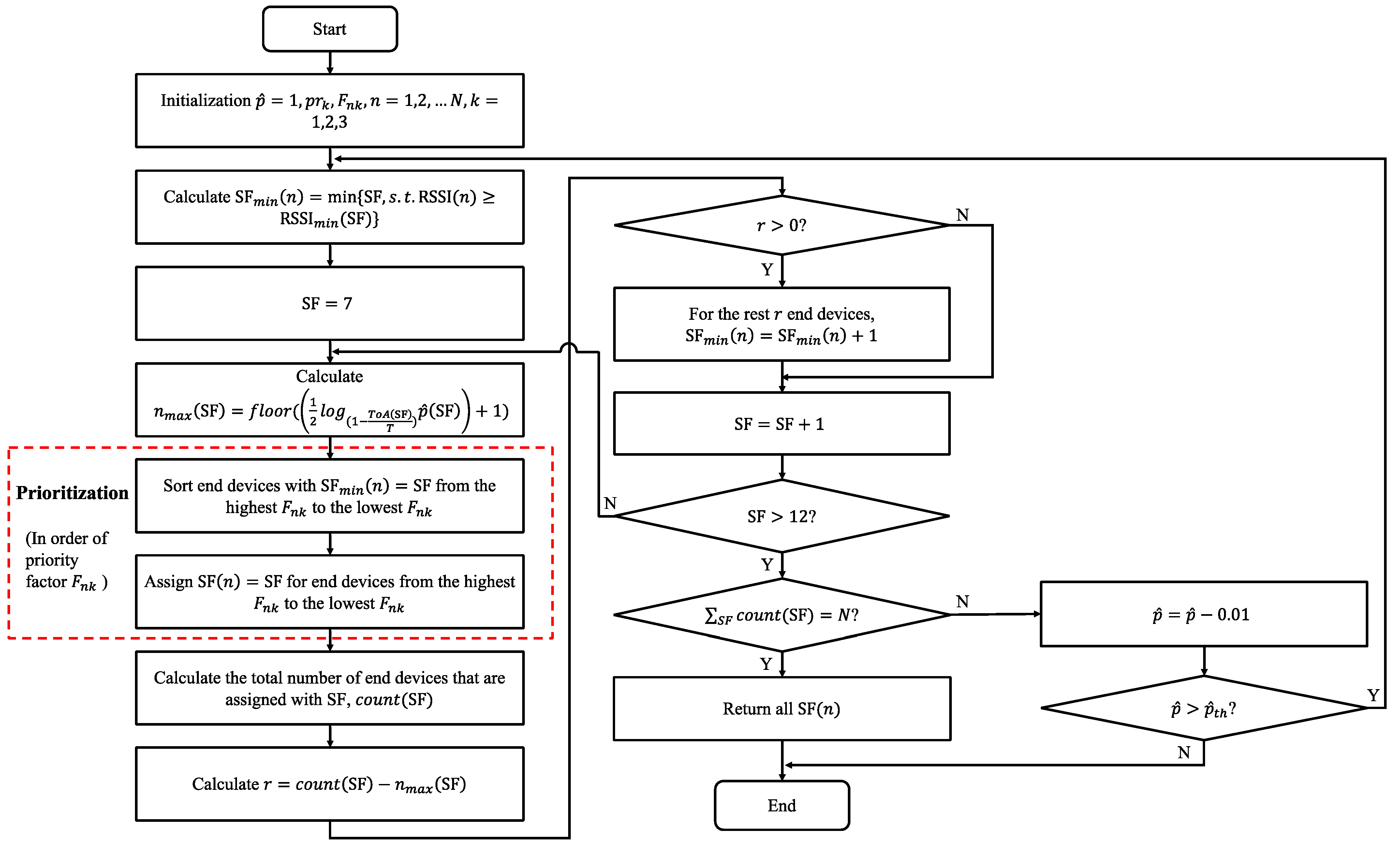

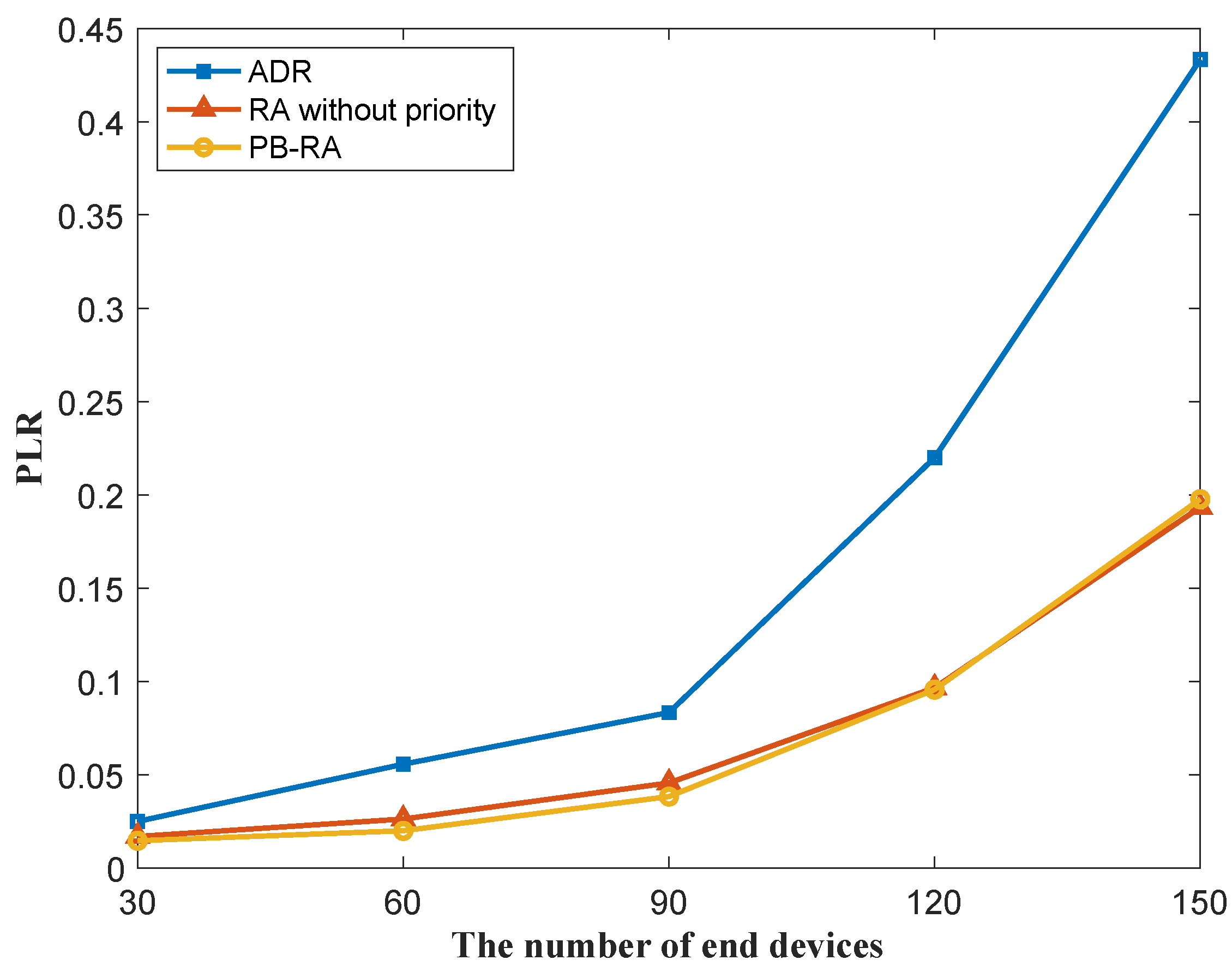
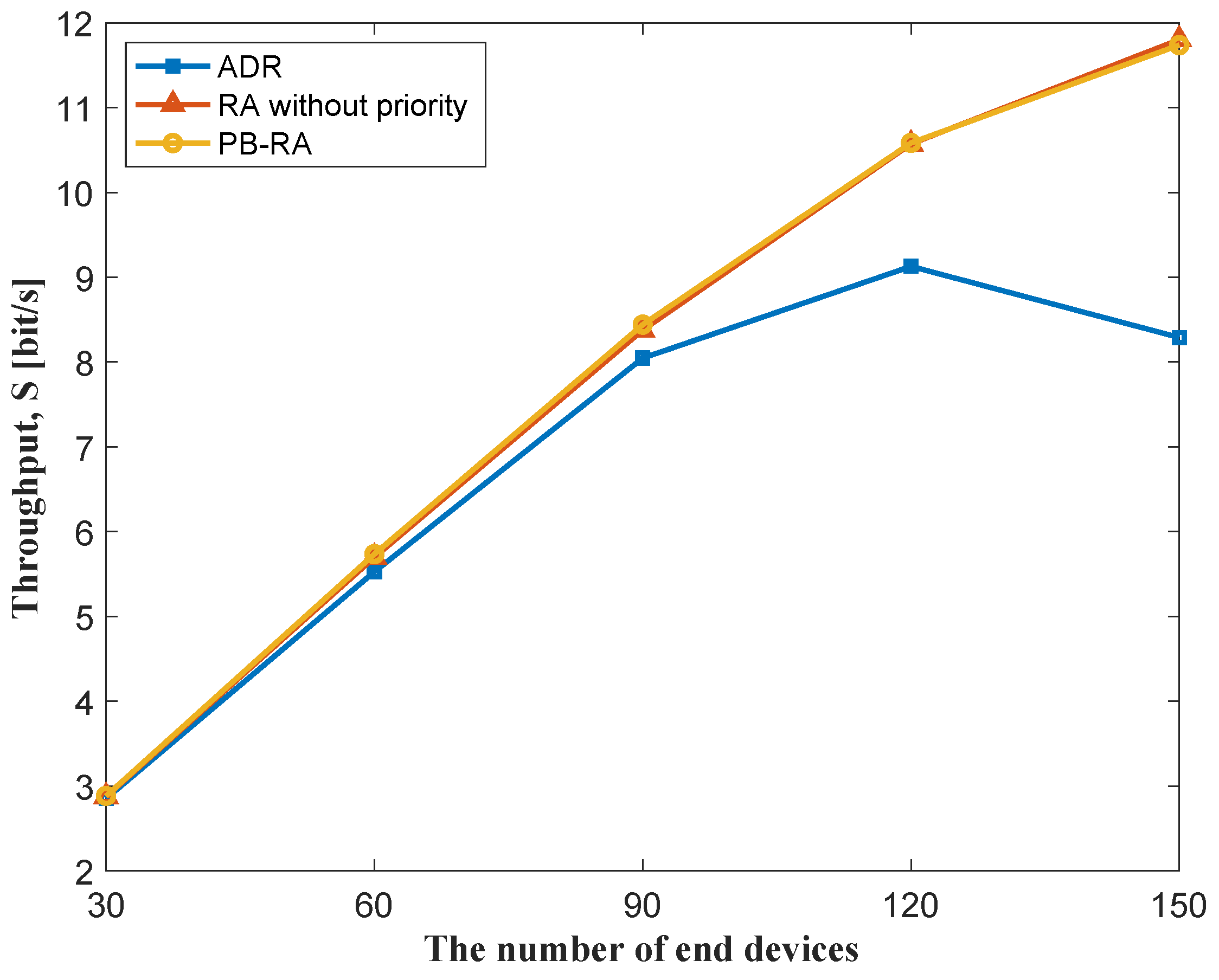

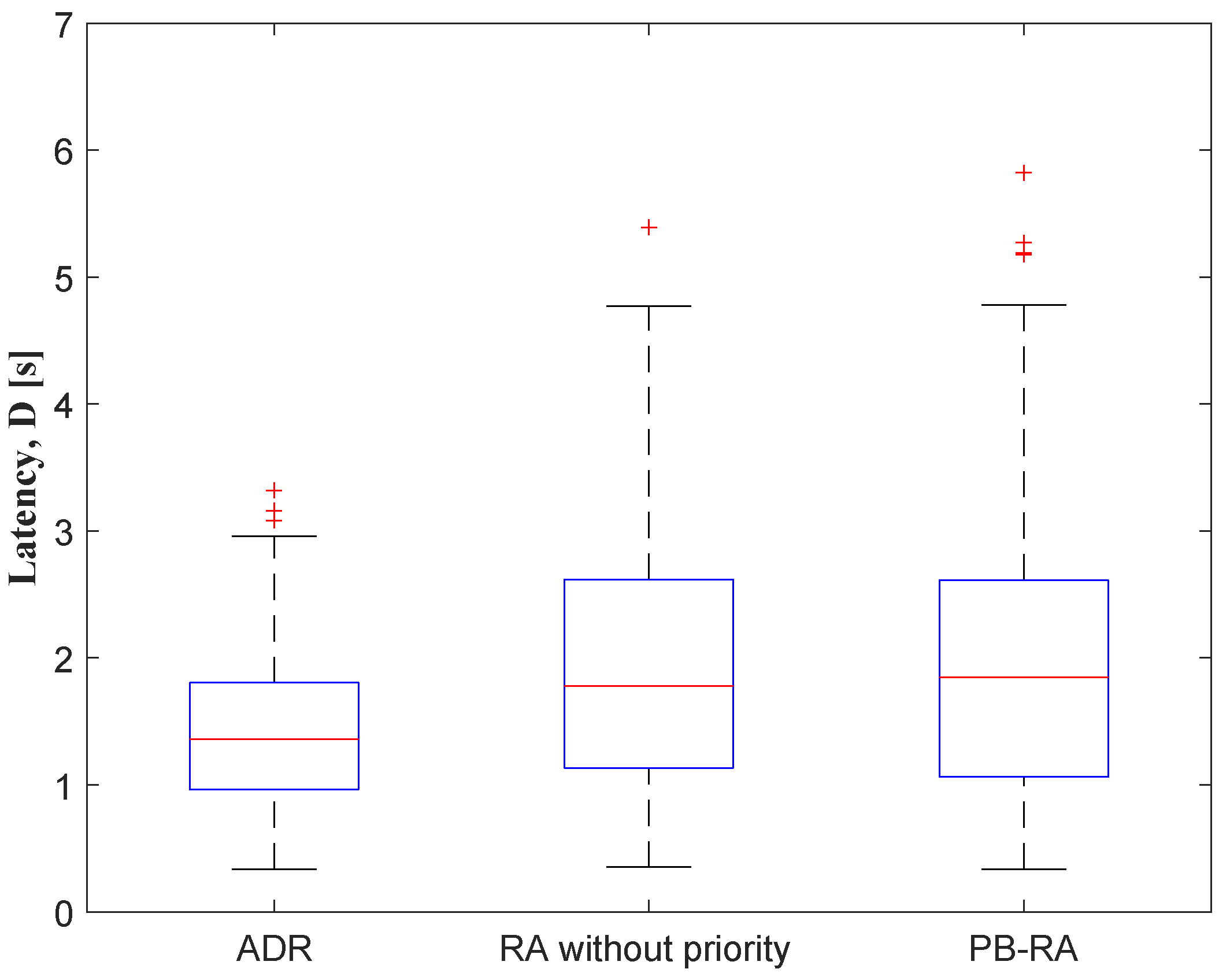

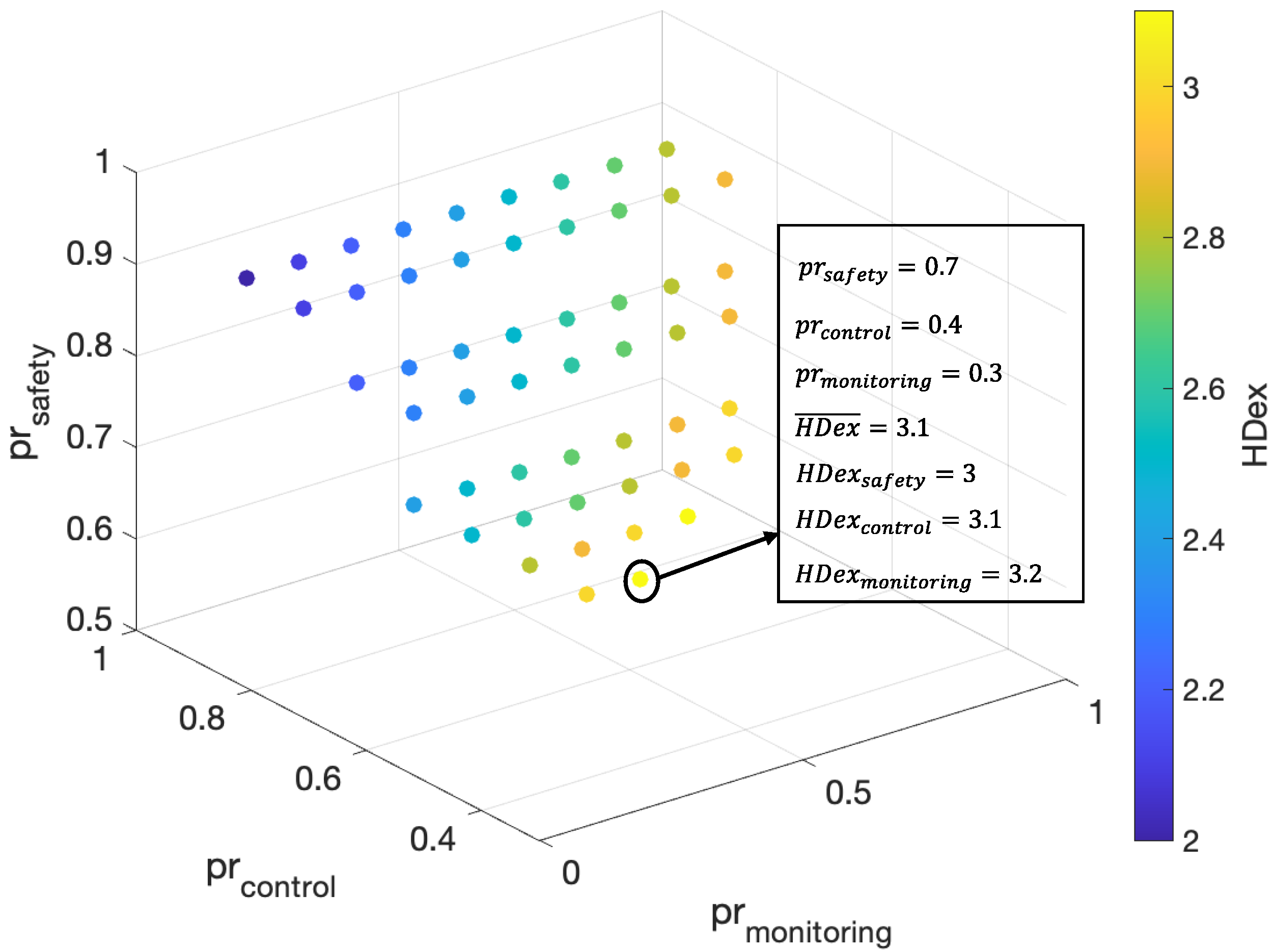
| [dBm] | −124.5 | −127 | −129.5 | −132 | −134.5 | −137 |
| 7 | 8 | 9 | 10 | 11 | 12 |
| HDex Level | Description | |||
|---|---|---|---|---|
| 1 | Bad | −200% | −200% | −200% |
| 2 | Poor | −100% | −100% | −100% |
| 3 | Fair | 0 | 0 | 0 |
| 4 | Good | +100% | +100% | +100% |
| 5 | Excellent | +200% | +200% | +200% |
| Parameters | Quantity | Configuration |
|---|---|---|
| LoRa gateway | 3 | Multitech Conduit modem with eight channels in AS923 |
| Network server | 1 | Chirpstack platform in virtual machine |
| End devices | 150 | Heltec WiFi LoRa 32 module |
| Safety Service model | - | Traffic 1. Alarms [22]: 5 packets/day, payload size = 20 bytes Traffic 2. Smoke detectors [22]: 2 packets/day, payload size = 20 bytes Expected PLR, latency, throughput: 1%, 1 s, 0.006 bits/s |
| Control Service model | - | Traffic 1. Smart lighting [21]: 5 packets/day, payload size = 20 bytes Traffic 2. Machinery control [22]: 100 packets/day, payload size = 20 bytes Expected PLR, latency, throughput: 1%, 3 s, 0.096 bits/s |
| Monitoring Service model | - | Traffic 1. Smart parking [22]: 60 packets/day, payload size = 20 bytes Traffic 2. Smart metering [21]: 144 packets/day, payload size = 20 bytes Expected PLR, latency, throughput: 10%, 10 s, 0.170 bits/s |
Disclaimer/Publisher’s Note: The statements, opinions and data contained in all publications are solely those of the individual author(s) and contributor(s) and not of MDPI and/or the editor(s). MDPI and/or the editor(s) disclaim responsibility for any injury to people or property resulting from any ideas, methods, instructions or products referred to in the content. |
© 2023 by the authors. Licensee MDPI, Basel, Switzerland. This article is an open access article distributed under the terms and conditions of the Creative Commons Attribution (CC BY) license (https://creativecommons.org/licenses/by/4.0/).
Share and Cite
Wei, Y.; Tsang, K.F.; Wang, W.; Zhou, M.M. Priority-Based Resource Allocation Optimization for Multi-Service LoRaWAN Harmonization in Compliance with IEEE 2668. Sensors 2023, 23, 2660. https://doi.org/10.3390/s23052660
Wei Y, Tsang KF, Wang W, Zhou MM. Priority-Based Resource Allocation Optimization for Multi-Service LoRaWAN Harmonization in Compliance with IEEE 2668. Sensors. 2023; 23(5):2660. https://doi.org/10.3390/s23052660
Chicago/Turabian StyleWei, Yang, Kim Fung Tsang, Wenyan Wang, and Morgana Mo Zhou. 2023. "Priority-Based Resource Allocation Optimization for Multi-Service LoRaWAN Harmonization in Compliance with IEEE 2668" Sensors 23, no. 5: 2660. https://doi.org/10.3390/s23052660
APA StyleWei, Y., Tsang, K. F., Wang, W., & Zhou, M. M. (2023). Priority-Based Resource Allocation Optimization for Multi-Service LoRaWAN Harmonization in Compliance with IEEE 2668. Sensors, 23(5), 2660. https://doi.org/10.3390/s23052660







